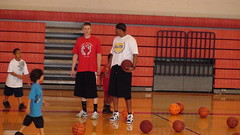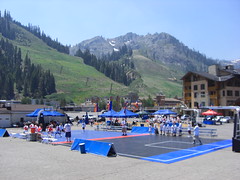>Jordan Rogers was coming off a screen during a summer practice with her club team when she jump stopped, and felt a stretch in her left knee.
OAS_AD(‘ArticleFlex_1’);
Suddenly she was sprawled out on the court.
Rogers did not hear or feel a pop, the tell-tale sign she had torn her anterior cruciate ligament. But she knew.
“It was the same stretch feeling as the first time,” said the Spanish Springs senior.
Rogers tore the ACL in her right knee, and both meniscus muscles, her freshman year while at Reed. This time it was just one meniscus, along with the ACL in her other knee.
“It just gave out on me, both times,” Rogers said.
She is not alone.
The most common age group for ACL injuries is 14 to 20, said Randy Jacobe of Nevada Physical Therapy, and 70 percent are non-contact injuries. An ACL tear does not repair itself. Reconstructive surgery, while effective, is costly and typically sidelines the athlete for six to nine months.
Furthermore, female athletes are up to eight times more likely to suffer ACL injuries than males, and studies have found one in every 50 to 100 female high school athletes and one in 10 Division I college athletes will tear an ACL.
“You don’t see the braces with the boys like you do the girls, especially these last couple years,” Reed girls basketball coach Sara Schopper said. “It’s amazing to me how (girls) knees are a little bit weaker.”
Weaker may not be the right word. The bodies of males and females are different, and research has shown there is an effect on the knee.
Hormones play a role, and it has been determined that women have a straighter knee when performing certain maneuvers in running and cutting than men, who tend to have more bend in their knees. Additional factors that place more of a strain on a woman’s knee include a straighter hip and slightly more outward deviation in the knee joint.
One finding from research specific to these gender differences is that women tend to activate their hamstring significantly less than men during some typical athletic maneuvers.
Is there prevention?
All of this information, though, is not new — a 1995 article in the American Journal of Sports Medicine found NCAA women’s basketball players were four times more likely to tear an ACL than their male counterparts — even if Northern Nevada has been hit by a rash of such injuries this year.
Besides Rogers, Reed’s Micha Walker, Elko’s Cierra Dunbar and most recently Yerington’s Karrie-Ann Quartz have suffered serious knee injuries. Rogers, Dunbar and Quartz are done for the season; Walker is just returning to action after undergoing surgery in August.
The injuries have drastically altered the basketball landscape, and have led some coaches and parents to look deeper into preventative measures.
“I don’t know why or what you can do,” Schopper said.
Spanish Springs coach Christine Eckles has long encouraged her players to join the school’s athletics weight class to help prevent all types of injury.
The University of Nevada implemented an ACL-injury prevention program last year. The offseason program focuses on the soccer, and women’s basketball and volleyball teams, and aims to strengthen the muscles around the knee.
“We’re trying to retrain the body on how to jump and land properly,” said Shelly Germann, interim director of sports medicine. “We did not have one serious knee injury in soccer this year. That says something.”
According to Dr. Thomas Haverbush, a Michigan orthopedic surgeon, the 2,200 ACL injuries suffered by female college athletes each year ran a reconstructing and rehabilitating bill of more than $44 million.
A training program developed at the University of Vermont Medical School designed to help prevent ACL injuries in skiers demonstrated a 69 percent decrease in injuries among ski patrol personnel and instructors who received the training compared to those who did not. Females who took part had injury levels equal to or only one to two times higher than their male counterparts.
Focus on strength
There are other nationally recognized programs that high school athletes can use.
Holly Silvers and her colleagues at the Santa Monica Orthopedic and Sports Medicine Research Foundation developed a program called “PEP” — prevent injury, enhance performance. Recent research published in the American Journal of Sports Medicine shows PEP can dramatically reduce ACL injuries in female athletes.
“We saw injury reduction of 74 percent to 88 percent,” Silvers said of one study involving soccer players between the ages of 14 and 18.
Jacobe has implemented aspects of the PEP program into his work with Walker, Wolf Pack athletes and others.
“We can’t change anatomy, that uncontrollable risk factor,” said Jacobe, who worked with Germann to develop the prevention program at Nevada. “But what we can change is the poor strength through the core.”
Female athletes tend to overdevelop their quads, Jacobe said, which stresses the ACL. But women can counteract the problem by learning to use their hamstrings, abdominals, gluteal muscles and calves more in jumping and landing.
There was a reduction in the ratio of knee ligament injuries in female athletes as compared to men from five times higher to only one or two times higher when athletes in a Cincinnati study were trained to rely more on their hamstring muscles than their quadriceps, Dr. Haverbush reported.
“When there is a weakness in the core, then the leg dives in and you go into the knock-kneed position,” Jacobe said. “You have to be strong everywhere.”
After determining that warm-up and workout programs aimed at prevention are successful, Silvers said the next frontier is to look at prepubescent girls.
“We want to study the true mechanism of the injury,” she said. “Can we ‘vaccinate’ 8, 9, 10 year olds, and keep them from developing bad habits and mechanics?”






















